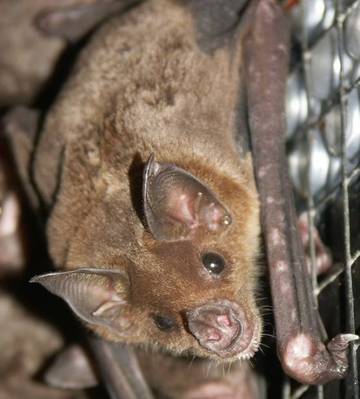The neural basis of bat sonar

Navigating on the wing in complete darkness is a challenging task for echolocating bats. It requires the detailed analysis of spatial and temporal information gained through echoes of their ultrasonic calls. Thus, neural encoding of spatio-temporal echo information is a major function in the bat auditory system. The auditory extraction of both temporal and spatial characteristics of echoes referenced to the emitted calls is essential for detecting prey and avoiding obstacles.
From the high number of echoes reflected towards the bat only few might provide useful information about objects of relevance. In addition, the information is highly directional. This spatial directionality is mediated by the interaction of the large sound-transformation structures (ears and nose leaves) and the high frequencies used by bats.
How does the bat auditory system deal with the complicated task of analyzing complex echo-acoustic scenes? How does a bat select objects of special interest from the multitude of echoes? And how are dynamic changes of echo-acoustic information induced by motion of the body, head or the large pinnae processed (and exploited) by the auditory system?
Standard animal model used to answer all these questions is the neotropical bat Phyllostomus discolor. Experimental approaches cover standard electrophysiological recording techniques as well as recordings with chronically implanted electrodes in freely behaving bats and electrical microstimulation. The use of head-related transfer functions allows acoustic stimulation in virtual space.
Earlier projects investigated neural coding of 3D object properties (e.g. Firzlaff et al 2006, 2007; Heinrich et al. 2011), while more recent work focused on spatio-temporal coding of complex echo-acoustic scenes (e.g. Hoffmann et al., 2013), echo acoiustic flow (Bartenstein et al, 2014, Greiter and Firzlaff, 2017) and multimodal interactions between bat sonar and vision, e.g.: Kugler et al., 2019).
A current project investigates the representation of multiple objects arranged along the spatial depth axis in the map of target-distance in the bat Phyllostomus discolor. The Project aims to reveal how many simultaneously present objects can be represented in the map, and up to which minimal distance two object can be resolved by single neurons.
Neural mechanisms of vocal learning in bats
A recent project was funded by the HFSP grant "The first mammalian model for vocal learning: a molecular, neural and comparative approach in bats".
The project was part of an international research effort that included the Max Planck Institute for Psycholinguistics (MPI) in the Netherlands, the Faculty of Biology LMU (Munich), and the University of Californina, Berkeley(USA).
So far, several publications originated from this project (e.g. Hörpel and Firzlaff, 2019; Hörpel et al., 2021), strongly highlighting the benefit of a multi-disciplinary collaboration (e.g. Vernes, SC., Devanna, P., Hörpel, SG., Alvarez van Tussenbroek, I., Firzlaff, U., et. al., 2022)
Funding of recent and current projects:
- DFG
- Volkswagen Foundation
- BCCN Munich
- HFSP
Collaborations:
- Prof. Dr. Lutz Wiegrebe († 29.11.2019), Dept. Biol. II, LMU, Munich
- Prof. Herbert Peremans, University of Antwerp
- Dr. Sonja Vernes, MPI for Psycholinguistics, Nijmegen